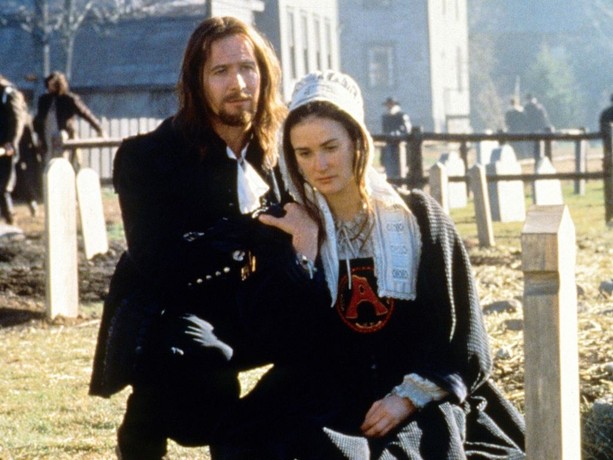“The Scarlet Letter” (1995) is a romantic drama film directed by Roland Joffé and loosely based on Nathaniel Hawthorne’s classic 1850 novel of the same name. Starring Demi Moore as Hester Prynne, Gary Oldman as Reverend Arthur Dimmesdale, and Robert Duvall as Roger Chillingworth, the film offers a highly dramatized and modernized adaptation of the original story, taking significant liberties with the plot and themes.

Set in 17th-century Puritan Massachusetts, the film follows Hester Prynne, a strong-willed and independent woman who emigrates from England to the American colonies ahead of her much older husband, Roger Chillingworth. When her husband is presumed lost at sea, Hester finds herself alone in a strict, deeply religious community. Over time, she forms a passionate and forbidden relationship with the town’s beloved minister, Arthur Dimmesdale.
Their secret affair leads to Hester’s pregnancy, a scandal that shocks the rigid Puritan society. When she refuses to name the father of her child, she is convicted of adultery and sentenced to public humiliation: she must wear a scarlet letter “A” (for “adulteress”) on her chest as a symbol of her sin. Despite ostracization and shame, Hester remains dignified and resilient, raising her daughter Pearl on the fringe of society.
The arrival of her missing husband, Roger Chillingworth, who has adopted a new identity, introduces a dark and vengeful element to the story. Chillingworth is determined to discover the identity of Hester’s lover and punish him, leading to a tense psychological and emotional battle. Meanwhile, Dimmesdale is tormented by guilt and fear, struggling with his conscience and societal expectations.

Unlike Hawthorne’s original novel, the 1995 film adaptation incorporates several new elements, including a more overtly romantic and sexual relationship between Hester and Dimmesdale, as well as a dramatically altered ending featuring violence and rebellion, which is not present in the source material. The film also emphasizes Hester’s independence and her defiance of societal norms, recasting her as a proto-feminist heroine.
Despite its lavish production values and strong performances, “The Scarlet Letter” (1995) was met with criticism for its departures from the novel, its melodramatic tone, and its attempt to transform a story about sin, guilt, and redemption into a sweeping romance. Nonetheless, the film visually captures the oppressive atmosphere of Puritan New England and explores enduring themes of love, judgment, and the courage to defy unjust authority.
In summary, “The Scarlet Letter” (1995) is a bold, controversial reimagining of a literary classic, focusing on the forbidden love between Hester Prynne and Arthur Dimmesdale, the destructive power of vengeance, and the resilience of a woman who dares to challenge the constraints of her society.





